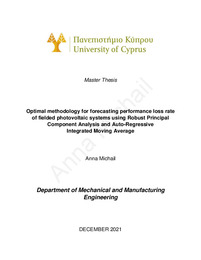| dc.contributor.advisor | Kyprianou, Andreas | en |
| dc.contributor.advisor | Georghiou, George Elias | en |
| dc.contributor.author | Michail, Anna | en |
| dc.coverage.spatial | Cyprus | en |
| dc.creator | Michail, Anna | en |
| dc.date.accessioned | 2022-03-28T11:15:49Z | |
| dc.date.available | 2022-03-28T11:15:49Z | |
| dc.date.issued | 2021-12 | |
| dc.identifier.uri | http://gnosis.library.ucy.ac.cy/handle/7/65118 | en |
| dc.description.abstract | Photovoltaic (PV) systems exhibit different degradation modes resulting to different performance loss rates (PLR). The degradation modes can be attributed to environmental and internal factors (e.g., temperature, humidity, soiling) as well as on PV module/system performance loss causes (shading, module/cell cracks and mismatches, etc.). The aforementioned factors result in reduction of PV module durability, which must be quantified through the estimation of the PLR. Up to date, there is no standardized method for estimating the PLR of fielded PV systems. In this work, an optimal methodology for forecasting the PLR of PV systems is presented using robust principal component analysis (RPCA) and seasonal auto regressive integrated moving average (SARIMA) methods. Specifically, SARIMA models, based on four different criterions (i.e., information and empirical criterions), were used to forecast the performance ratio (PR) time series of fielded PV systems. Thereafter, the RPCA method was used to estimate the PLR based on the forecasted PR values. The initial results of the comparative analysis for identifying the optimal SARIMA model to estimate the PLR, showed that even if the derived models from the evaluation might not be the most statistically significant (in terms of residuals behaviour), they can result to good PR estimations with root mean squared errors (RMSE) below 6%. The results also demonstrated that models based on empirical criterion (empirical evaluation of the autocorrelation function (ACF), partial ACF (PACF) and a statistical residual analysis) had in almost all cases (for 10 out of 11 systems) the least preferable values. Furthermore, the residuals’ analysis and autocorrelation coefficients showed that the models based on Bayesian Information Criterion (BIC) had the least preferred behaviour, while the residuals of the empirical criterion had the most preferred behaviour. However, by performing the Ljung-Box portmanteau test, all SARIMA models proved to model the PR time series adequately (no lack of fit). Finally, by comparing the actual and forecasted PLR values, it was observed that all the derived models manage to estimate the PLR sufficiently with absolute differences up to 1.2%/year, confirming the reliability of the RPCA method to estimate the PLR, even by using forecasting PR values. | en |
| dc.description.sponsorship | Photovoltaic Technology Laboratory of FOSS Research Centre for Sustainable Energy | en |
| dc.language.iso | eng | en |
| dc.publisher | Πανεπιστήμιο Κύπρου, Πολυτεχνική Σχολή / University of Cyprus, Faculty of Engineering | |
| dc.rights | info:eu-repo/semantics/openAccess | en |
| dc.rights | Open Access | en |
| dc.title | Optimal methodology for forecasting performance loss rate of fielded photovoltaic systems using Robust Principal Component Analysis and Auto-Regressive Integrated Moving Average | en |
| dc.title.alternative | Βέλτιστη μεθοδολογία για την πρόβλεψη του ποσοστού απώλειας της απόδοσης εγκατεστημένων φωτοβολταϊκών συστημάτων με χρήση των τεχνικών Robust Principal Component Analysis και Auto-Regressive Integrated Moving Average | el |
| dc.type | info:eu-repo/semantics/masterThesis | en |
| dc.contributor.committeemember | Loucas, Louca | en |
| dc.contributor.committeemember | Grigoriadis, Dimokratis | en |
| dc.contributor.department | Τμήμα Μηχανικών Μηχανολογίας και Κατασκευαστικής / Department of Mechanical and Manufacturing Engineering | |
| dc.subject.uncontrolledterm | ΠΟΣΟΣΤΟ ΑΠΩΛΕΙΑΣ ΑΠΟΔΟΣΗΣ | el |
| dc.subject.uncontrolledterm | ΦΩΤΟΒΟΛΤΑΪΚΩΝ ΣΥΣΤΗΜΑΤΩΝ | el |
| dc.subject.uncontrolledterm | ΠΟΣΟΣΤΟ ΥΠΟΒΑΘΜΙΣΗΣ | el |
| dc.subject.uncontrolledterm | ROBUST PRINCIPAL COMPONENT ANALYSIS | en |
| dc.subject.uncontrolledterm | SEASONAL AUTO-REGRESSIVE INTEGRATING MOVING AVERAGE MODEL | en |
| dc.subject.uncontrolledterm | PERFORMANCE LOSS RATE | en |
| dc.subject.uncontrolledterm | PHOTOVOLTAIC SYSTEMS | en |
| dc.subject.uncontrolledterm | DEGRADATION RATE | en |
| dc.author.faculty | Πολυτεχνική Σχολή / Faculty of Engineering | |
| dc.author.department | Τμήμα Μηχανικών Μηχανολογίας και Κατασκευαστικής / Department of Mechanical and Manufacturing Engineering | |
| dc.type.uhtype | Master Thesis | en |
| dc.contributor.orcid | Kyprianou, Andreas [0000-0002-5037-2051] | |
| dc.contributor.orcid | Georghiou, George Elias [0000-0002-5872-5851] | |
| dc.contributor.orcid | Michail, Anna [0000-0001-5139-6007] | |
| dc.gnosis.orcid | 0000-0002-5037-2051 | |
| dc.gnosis.orcid | 0000-0002-5872-5851 | |
| dc.gnosis.orcid | 0000-0001-5139-6007 | |

